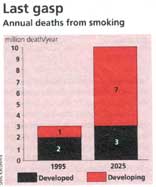Fatal fags
 ONE person dies of smoking every 10 seconds somewhere in the world, but the worst is yet to come, reveals a recent study. Richard Peto of the Imperial Cancer Research Fund in Oxford, UK, one of the authors of the study, who was recently in Delhi to attend the 16th International Congress on Cancer, warns, "If current smoking patterns persist, then by the time the young smokers of today reach middle age or old age there will be about 10 million deaths per year from tobacco -- 1 death every 3 seconds. Tobacco is already the biggest cause of death in developed countries. Over the next few decades, tobacco could well become the biggest cause of adult death in the world."
ONE person dies of smoking every 10 seconds somewhere in the world, but the worst is yet to come, reveals a recent study. Richard Peto of the Imperial Cancer Research Fund in Oxford, UK, one of the authors of the study, who was recently in Delhi to attend the 16th International Congress on Cancer, warns, "If current smoking patterns persist, then by the time the young smokers of today reach middle age or old age there will be about 10 million deaths per year from tobacco -- 1 death every 3 seconds. Tobacco is already the biggest cause of death in developed countries. Over the next few decades, tobacco could well become the biggest cause of adult death in the world."
The study, Mortality from smoking in developed countries 1950-2000, is a collaborative project undertaken by Peto and his colleague Jillian Boreham, Alan Lopez of the Geneva-based World Health Organization, and Michael Thun and Clark Heath Jr of the American Cancer Society, Atlanta. The study is based on data collected by the American Cancer Society and the WHO, and collated by the scientists at the Imperial Cancer Research Fund.
According to Peto and his colleagues, by 1995 some 3 million people will die of tobacco-related ailments each year worldwide, and by AD 2025, the figure will rise to about 10 million. Concurs Lopez, "In developed countries, death from tobacco is already the biggest epidemic that WHO is faced with. Between 1950 and 2000, tobacco will have killed about 60 million people in the developed countries alone."
The study reveals that evidence from the US and the UK indicates that those who start smoking regularly in their teens are particularly at risk and if they continue to smoke about half will eventually be killed by tobacco -- about a quarter in old age and another quarter whilst still middle aged. Those killed by tobacco in their middle age live some 20-25 years less than they may have if they had not been smokers.
Peto explained that the effects of an increase in smoking are only seen after several years. In the US, for example, till 1945 there was a large increase in the number of men smoking, but there was no corresponding increase in the number of deaths related to lung cancer. However, from 1945 to 1985, the number of deaths from lung cancer increased although there was no large increase in cigarette use.
The study revealed that it wasn't necessarily heavy smokers that died of tobacco-related ailments, but most smokers who did die started smoking as teenagers. Stopping smoking before any serious disease, like cancer or heart disease developed, the study revealed, does protect people from the risk of developing these diseases later. Contrary to popular belief, fewer smokers die of lung cancer than of other diseases.
According to statistics collated by the US Surgeon General, of the 400,000 tobacco-related deaths in the US in 1985, only 110,000 smokers died of lung cancer, whilst 290,000 people died of vascular and other diseases. However, of the total cancer deaths among men in developed countries, about half of those in middle age were due to tobacco, and in the US more women die of lung cancer than of breast cancer, a major killer among US women.
Data from the developing world is fragmented and Peto is planning to collaborate with the Bombay-based Cancer Research Institute and the Indian Council of Medical Research to generate and collate relevant data from India. He reckons that about 30 to 40 per cent of the adults in China, India, Indonesia and parts of South America smoke. Data from China reveals that by AD 2025, some 2 million people will die of tobacco-related deaths each year.
